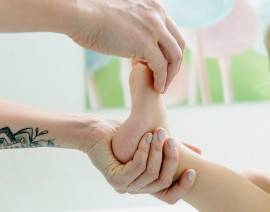- 905.829.0724
- info@yourhealthwellnesscentre.com

Did you know that chiropractors treat pediatric patients as well as adults? Many chiropractors have additional special training in treating pediatric populations, and Dr Carole Smith is currently completing her Masters in Integrative Pediatrics at Logan University and helps to teach pediatric care at CMCC. In this series of articles, she will answer some common questions about pediatric chiropractic care.
Although we may see children as smaller versions of adults, there are many differences physically – as well as in the feelings, demands, needs, behaviours, and thoughts of children – that require us to modify our approach to the physical exam of children. In infants and younger children, we may want to suggest starting the exam in the caregiver’s lap. In infants, this can help with temperature regulation, as well as comfort as a stranger is approaching them. By having an older child start the exam in their parent’s lap, the child may feel more at ease and provide a sense of familiarity to help the pediatric patient feel at ease. When we do approach the child when they are in the caregiver’s lap or on the table, we also want to be mindful that we are on the same level as the child, and not towering over them by either kneeling, using a stool, or raising the table higher.
We want to start with the least invasive, or the “quiet” parts of the exam, first to minimize the distress that the child may be feeling and to help us get a good reading of things, such as vital signs when they are not upset. It is important to note, however, that we may need to vary the order or examination based on the child’s behaviour or temperament.
Posting signs and explaining what we are doing and what to expect can also help older children feel more comfortable in our office and with the physical exam. We often like to use a visual schedule to show kids the order of the exam, then they get to peel off the part we have done and put it in the “All done” pocket and point to the next activity on the schedule.
While it is important for us to explain what we are doing, and our findings, in an age-appropriate manner, sometimes distractions are necessary. This may involve telling a story, singing a song, or demonstrating what we are going to do on a stuffed animal or doll. Furthermore, young children may be more at ease if they have a tablet or their favourite show to distract them as we are assessing, so we find many of our parents will bring these things for their child to the appointment. In our clinic, we like to use spinner toys (that light up and spin) to help get attention and provide distraction for young children.
For more information on pediatric chiropractic care or to book your appointment, reach out to us at the clinic either by email (drcarole@yourhealthwellnesscentre.com) or phone 905.829.0724.